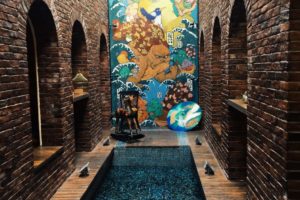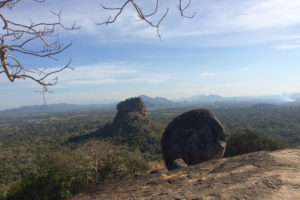I visited Cuba in 2014 with a couple of friends, flying into Havana straight from London Heathrow. Cuba’s an incredible place, vastly different to any other nation in the region and frozen in the 1960s. Classic American cars are a standard taxi ride here. Billboards on the sides of the motorway weren’t advertising Apple products or sports cards. Instead, giant images of Che and inspiration pro-socialism quotes decorated the landscape. The CUC (convertible peso – equal to the dollar) and CUP (local peso) was also a monetary system I couldn’t quite get my head around, especially when I realised the already cheap meals I was buying were only a quarter of the price for a Cuban (a pizza was $1 for us and 25 cents for a local).
Days 1-3 Havana
The start of our trip. Sunset walks down the Malecón and book-browsing in Cuba’s Plaza de Armas. I bought a couple of high-quality prints of 1960s Cuban films (really printed onto the paper, not digitally).

Days 3-5 Viñales
Viñales, on the northwest coast of Cuba, consisted of one dirt track road in the centre of the town. The lush greenery of the area was a little Jurassic Park-esque, it was very beautiful. We took a horseback tour of the surrounding hills, arranged by the guesthouse we stayed in, and visited a local tobacco grower’s plantation. He rolled a cigar in front of us and explained to us the use of each part of the tobacco plant. It was interesting to learn that whilst 90% of the farmer’s crop has to be given to the government, the remaining 10% is free for the farmer to sell.
Days 5-8 Trinidad
From Viñales we took a taxi to Trinidad, a UNESCO heritage site. As there were four of us, it was cheaper to take taxis between towns, although the bus may be cheaper if there are fewer people in your group. My mother travelled alone to Cuba and took the buses around without incident. The pretty cobbled streets and low pastel-coloured houses reminded me of the Pelourinho in Salvador, Brazil, remnants of a bygone Portuguese colonial era. Although there were some classic American cars here, most of the transport was by horseback. We explored the surrounding area of the town on horses and stopped at a waterfall for a swim. We also had some Cuban coffee at a small wooden stall near the waterfall, where the man prepared coffee beans for us using a giant pestle and mortar.
At night, we went to La Cueva, a massive cave club randomly located in Trinidad. Complete with dripping water from the ceiling and stalactites and stalagmites, this was a very fun going out option that you have to see if you’re in the area.

Days 8-10 Santa Clara
Santa Clara, the sacred pilgrimage spot for Che worshippers. There was a much more decidedly anti-American and pro-socialist air of sentiment in this student city, displayed through graffiti and street art. We visited Che Guevara’s mausoleum and memorial where his remains are kept, along with 29 of his fellow revolutionaries. We also wandered around the University of Santa Clara and although there was not much to be seen, the lecture buildings and student accommodation appeared rather rudimentary. We used an internet cafe in Santa Clara for half an hour and paid the equivalent of $5, pretty expensive considering the average Cuban wage only amounts to about $15. Young people we met along the way, and in Havana, were very interested to hear about life abroad, as a simple Google search was not in the picture for them.
Days 10-12 Cojímar
Cojimar was where we had the strangest casa familiar experience. The town itself is a little fishing village on the outskirts of Havana, where Ernest Hemingway based ‘The Old Man and the Sea’. When we arrived, we found the place that we had booked online (we mostly stayed in casa familiares referred to us by word-of-mouth or that we’d found roaming the streets), with intense hi-tech security protection amidst houses that were rather the opposite. Our host, Candida, somehow didn’t hear the doorbell even though we tried both the front and back doors, for about an hour. We ended up having to sit at the restaurant next door to see if there’d be any movement from the house. Eventually she came out and showed us to our room, saying nothing more than “mhm mhm” in a soft high-pitched voice (which my friend and I have now adopted in tribute). We later found her website, upon our return to England, and the internet, which was a collection of her poems (it was something like candypoet.com but I can’t find it anymore) with an emphasis on the erotic and sensual.
Her neighbours were so lovely though. We asked for directions to a good beach and one of them with a car invited us to hop on in. He drove us to a beautiful white-sand beach 20 minutes away and adamantly refused the money we handed him as payment.
Days 12-14 Havana
Before we left, we asked our the owner’s son at our casa familiar if he could help us source some Cuban cigars. He’d told us he had friends who worked on the factory line and would sneak a few boxes home to sell. He was very happy to oblige when we did call upon his services, frantically telling us to wait a moment so he could go fetch them, ‘from the factory’. He sprinted out the door and about 10 minutes later, huffing and puffing, he returned with several boxes of Cohibas and Romeo y Julietas under each arm. They were significantly cheaper than on the high street, about $25 a box, although I did express my doubts as to their authenticity (I mean, the Cohiba boxes were all different shapes, sizes and shades of orange…).
On the way to the airport, our taxi set on fire. Our first hint that something was up was the thick black smoke aggressively pouring out the dashboard of the car. The driver and his companion were panicking, whilst pumping reggaeton continued to blast out from the boomboxes behind us. They stopped on the hard shoulder and quickly lifted up the hood of the car. We hopped out too, just in case, and watched them experimenting with the mechanics inside the car. I just hoped that the Cuban state education system, as great as it is, offered basic engineering lessons. After a bit of banging around and some flapping (I think they extinguished the fire) they got back into the car. I asked if everything was ok and they replied “Si, si, no pasa nada”. Seeing as we needed to get on that plane back home, and we weren’t too far off (only about ten minutes away), we took our chances and hopped back in. Those ten minutes were pretty nerve-wracking but everything passed without further incident.
Although I enjoyed my travels in Cuba, there were times when I felt quite down seeing just how poor and economically underdeveloped the country was. We were chatting to some young students in a square in Havana, who told us that they could be arrested for the very act of talking to us. It’s a stunning country with some amazing people but I almost felt a bit like a voyeur there. Despite speaking Spanish and having some great conversations with people, there always seemed to remain an invisible barrier that uncomfortably highlighted the fact that Cubans and foreigners in Cuba could never properly mingle, a feeling of ‘us’ and the ‘them’. I’d been wooed by the romantic portrayals of Cuba in film and the arts, by their contributions to music, dancing and literature (hello Dirty Dancing 2: Havana Nights), that the actual reality of life there hit me very hard.






